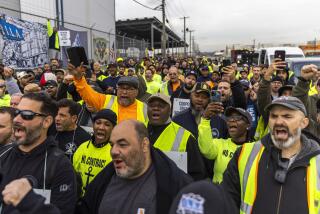U.S. Shipyards Face Dim Future : Hit by Lack of Contracts, Labor Disputes, Layoffs
- Share via
BATH, Me. — The Arleigh Burke is still on the drawing boards, but the Navy’s newest and toughest guided-missile destroyer already is taking heavy casualties in the nation’s embattled shipyards.
Although the giant Bath Iron Works won a $322-million Navy contract last April to build the first Burke-class warship, the company’s 4,500 production workers walked out seven weeks ago over wage and benefit concessions that the company now says were needed to bid the contract. Company and union negotiators have met only twice--most recently on Tuesday--since the bitter strike began July 1.
Across the nation, in San Pedro, Calif., Todd Shipyards, which lost in its bid for the same contract, has laid off 2,800 workers since mid-1983. About 2,600 Todd workers are completing three missile frigates, but company officials say that layoffs will continue--and that the shipyard may close--unless more work is found.
The problems in both yards reflect those of America’s once-mighty shipbuilding industry: Commercial shipbuilding is nearly dead, labor-management disputes are widespread and future prospects are dim.
Twenty-five of the nation’s 110 shipyards have closed since 1981, and dozens more may close by the end of the decade, said Jed Babbin, vice president and general counsel of the Shipbuilders Council of America, an industry trade group in Washington.
“The U.S. Navy is the only customer in town,” Babbin said. “Commercial shipbuilding has disappeared. There were only five orders in the last five years.”
About 25,000 shipyard workers have lost their jobs since 1981. In Washington state, more than 4,000 jobs at shipyards in the Puget Sound area have disappeared just in the last two years. Last month, General Dynamics Corp. announced that next year it will close its sprawling 180-acre shipyard in Quincy, Mass., putting another 4,200 out of work. Even the Navy is laying off 5,000 civilian workers at its own eight shipyards.
Repair Contracts
Len M. Thorell, Todd vice president and general manager of the San Pedro shipyard, said in a telephone interview that Todd is bidding for contracts to repair Navy ships and will try again in 1987 for follow-up ships in the Burke class. The Navy plans to buy at least 29 Burke destroyers.
But, speaking of the yard’s work force, he warned: “It runs to zero if we don’t get new work, and we run out of work in 1988.”
Everett Pyatt, assistant secretary of the Navy for shipbuilding and logistics, said the Navy is simply seeking more competitive work and is “just letting happen what’s happening.” Speaking of the failing shipyards, he said: “You can’t keep them all.”
Hurt by Higher Costs
West Coast shipyards will win Navy contracts only if they offer low bids, Pyatt said. Todd was $91 million higher than Bath on its destroyer bid, and company officials say they are hampered by higher production and labor costs of $13.48 an hour, about $2 more than Bath Iron Works pays.
But Pyatt said the Navy will not award Todd contracts just to keep its yard alive. “They really need to focus up to the managerial issues of controlling costs the way the other yards have,” Pyatt said. “We’re the Navy of the whole country. We can’t send work to one section of the country when other yards can do the work more efficiently.”
Analysts say that the loss of federal subsidies and the challenge of foreign competition is more to blame for the industry’s decline than Navy policy is.
In the first case, President Reagan canceled a 44-year-old federal subsidy program in 1981 that had provided up to half the cost of building commercial ships. In the second, the International Trade Commission reported in April that U.S. shipbuilders charge twice as much and take twice as long as shipyards in Korea and Japan. Those two countries build more than half the world’s commercial ships today.
Under the law, the Navy must buy American. With only one customer, the competition among shipyards has been fierce to cut costs and win contracts. As a result, Pyatt said, shipyards have saved the Navy $2.5 billion below projected costs in the last three years.
Bath Iron Works President William E. Haggett cited the cutthroat competition when he first asked employees for concessions last summer. But members of Local 6 of the Industrial Union of Marine & Shipbuilding Workers voted 3,500 to 24 in June to reject a proposed three-year wage freeze, two-tier salary structure, reduced health benefits and other concessions.
Union members say the proposed two-tier wage system, in which new employees would permanently earn $3 less per hour, rankles most. Many of the workers have followed their fathers and grandfathers into the shipyard.
“You have successive generations of the same families working here,” said Milt Dudley, a Bath Iron Works mechanic and strike coordinator. “Essentially what they’re asking us to do is sell out our own children. And that’s not palatable to the people here.”
Bath Iron Works, a subsidiary of the privately owned Congoleum Corp. of Portsmouth, N.H., has refused to publicly document its contention that concessions were necessary to win the Navy contract. But a state judge last week allowed the union to release Navy bidding documents indicating that the company will earn an $80-million profit on the Burke destroyer and two AEGIS class cruisers.
In a company statement, Haggett said the profits would be spread over five years and would be cut by taxes and interest. He added that the profit margin was a reduction, compared to previous bids.
That argument does not convince many on the around-the-clock picket lines outside the 54-acre main yard, where a towering red-and-white-striped crane dominates the skyline and a sign on the front gate proudly proclaims: “Through these gates pass the best shipbuilders in the world.”
“If they were really hurting, that’s one thing. I could swallow hard and hurt with ‘em,” said Mickey Meader, a 37-year-old pipe fitter. “But they’re not hurting. We are.”
More to Read
Sign up for Essential California
The most important California stories and recommendations in your inbox every morning.
You may occasionally receive promotional content from the Los Angeles Times.














